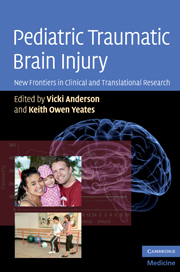Book contents
- Frontmatter
- Contents
- List of contributors
- Acknowledgments
- Introduction: Pediatric traumatic brain injury: New frontiers in clinical and translational research
- 1 Biomechanics of pediatric TBI
- 2 Neurobiology of TBI sustained during development
- 3 Using serum biomarkers to diagnose, assess, treat, and predict outcome after pediatric TBI
- 4 Clinical trials for pediatric TBI
- 5 Advanced neuroimaging techniques in children with traumatic brain injury
- 6 Neurobehavioral outcomes of pediatric mild traumatic brain injury
- 7 Very long-term neuropsychological and behavioral consequences of mild and complicated mild TBI: increased impact of pediatric versus adult TBI
- 8 Neurobehavioral outcomes of pediatric traumatic brain injury
- 9 Neuropsychological rehabilitation in children with traumatic brain injuries
- 10 Psychosocial interventions
- 11 Pediatric TBI: challenges for treatment and rehabilitation
- 12 Integrating multidisciplinary research for translation from the laboratory to the clinic
- Index
- Plate section
- References
4 - Clinical trials for pediatric TBI
Published online by Cambridge University Press: 14 May 2010
- Frontmatter
- Contents
- List of contributors
- Acknowledgments
- Introduction: Pediatric traumatic brain injury: New frontiers in clinical and translational research
- 1 Biomechanics of pediatric TBI
- 2 Neurobiology of TBI sustained during development
- 3 Using serum biomarkers to diagnose, assess, treat, and predict outcome after pediatric TBI
- 4 Clinical trials for pediatric TBI
- 5 Advanced neuroimaging techniques in children with traumatic brain injury
- 6 Neurobehavioral outcomes of pediatric mild traumatic brain injury
- 7 Very long-term neuropsychological and behavioral consequences of mild and complicated mild TBI: increased impact of pediatric versus adult TBI
- 8 Neurobehavioral outcomes of pediatric traumatic brain injury
- 9 Neuropsychological rehabilitation in children with traumatic brain injuries
- 10 Psychosocial interventions
- 11 Pediatric TBI: challenges for treatment and rehabilitation
- 12 Integrating multidisciplinary research for translation from the laboratory to the clinic
- Index
- Plate section
- References
Summary
Introduction
Trauma and, in particular, traumatic brain injury (TBI) remain the leading causes of death and disability in children in the United States and around the world. Despite multiple preventive measures and educational programs, (i.e. Think First, Safe Kids, etc.) the mortality from trauma is greater than all other pediatric diseases combined (Arias et al., 2002). TBI specifically is the leading contributor to death and disability in this traumatically injured population and of those children that suffer TBI, approximately 10%–15% are considered “severe.” These patients unfortunately go on to have permanent brain damage and deficits and, in many instances, will require long-term supportive care. As well, what is unclear in TBI is those children that have suffered only “mild” or “moderate” injuries, many of whom are also frequently disabled with neurocognitive, executive function, and/or behavior deficits that impact on activities of daily living, scholastic performance, and eventually vocational choice. Unfortunately, little is known of the mechanisms contributing to these deficits as well as therapeutic interventions to try and minimize or mitigate the damage and improve outcome. This lack of understanding is a direct result of the lack of scientific studies and ultimately of clinical trials for children following TBI.
It is clear that to move forward with research in the area of TBI particularly in the pediatric population it is important to identify the status of the field and understand the extent of research and knowledge in the present day.
- Type
- Chapter
- Information
- Pediatric Traumatic Brain InjuryNew Frontiers in Clinical and Translational Research, pp. 54 - 67Publisher: Cambridge University PressPrint publication year: 2010
References
- 4
- Cited by

